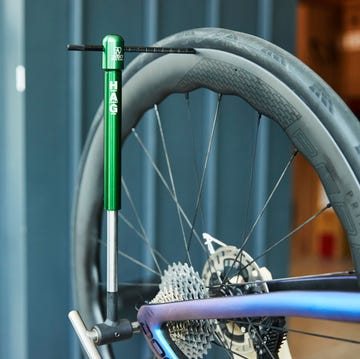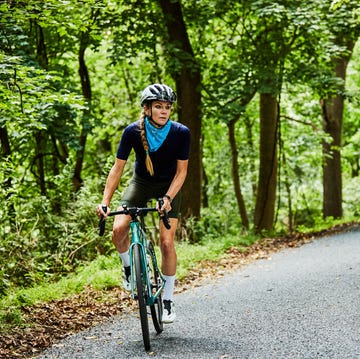If you’re hitting 100 miles of riding on a regular basis, you’re not just training to ride or race a century: You’re actually training for a greater distance, like a double century.
That’s right: If you can ride 100 miles, you’re ready to train for 200... if that’s something that intrigues you. But how do you ratchet your century training up to prepare for a 200-mile ride? It’s not as simple as doubling the distance—and the good news is, it’s a lot easier.
In fact, when bikepacker Tyler Pearce was speaking to Bicycling for an article about doing extremely long rides, he said if someone can ride 60 miles without stopping, they can ride 1,000 miles. “I know that sounds like it’s a huge jump,” he added. “But if your body can comfortably withstand 60 miles, any distance beyond that really just becomes about pacing and fueling.”
Don’t Train for 200 Miles by Riding 200 Miles
“You do not have to, nor should you—with few exceptions—ride 200 miles in training if you plan to do a 200 mile race or ride,” says cycling coach and gravel racer Dylan Johnson. “Doing a training ride that is too long may actually be counterproductive if you can’t recover well, because you will end up with less quality training for the week even though you rode a lot on one day.”
Do Increase Your Long Ride Duration
While you don’t need to ride 200 miles, Johnson is a firm believer in the long endurance paced ride at least biweekly. “Long rides are still important and I would shoot to do a six- to eight-hour ride once a week or once every two weeks, depending on your ability level and time constraints,” he says. “For most people, just keep this ride at zone 2—endurance pace—rather than trying to add in intervals or hard efforts.”
Check in on Your Long Rides
Riding for 200 miles or more becomes largely about mitigating discomfort, says cycling coach and Unbound XL winner Kristen Legan. She has clients use their long rides to test their saddles, handlebar, and gloves, fueling and light setups, looking for any signs of discomfort after a few hours of riding. Changing a saddle after an uncomfortable 80-mile ride is much better than having the saddle sores that come from 200 miles of rubbing and chafing.
Keep Speed and Strength in Your Training
Former WorldTour rider Ian Boswell made headlines a few years ago when he admitted to training under 20 hours per week to get ready for the 200-mile Unbound race, which he won. That’s because going from 100 to 200 or even to 350 miles of riding isn’t as different as you might think, especially from the physiological side of things.
“The athletes I work with are not going out and just doing giant rides all the time; they keep speed and strength elements in their training plan. I think that helps them be more efficient,” Legan says. Beyond that, you are likely already training as much as you can during the week, so there’s not much you can add to your training load other than on weekends.
Following a standard century training plan and simply increasing your longest ride of the week’s duration to that six-to-eight-hour sweet spot is going to get you to your goal. Push much more than that and you're heading for burnout.
Check Your Timing—and Prepare for a Night Ride
Planning your 200-miler for a summer day makes sense because you’ll maximize your daylight hours. But a 200-mile ride can very easily take 2.5 times what it takes you to ride 100 miles, especially if you have mechanical issues or a couple of extended refueling stops. Expect that you may end up out past sundown and pack accordingly.
This may mean bringing an extra jacket if temps dip at night in your area, and it definitely means having a fully charged front and a rear light on your bike. At dusk, turn on that rear light so you’re more visible to cars that may not be expecting a rider out at 8 p.m. If you haven’t ridden at night before, consider starting one of your long rides later in the day so you’re riding into the evening to get used to the feeling.
The Longer You Go, the More Prepared for Disaster You Should Be
Legan says that the secret to success when it comes to going long is being prepared for the inevitable things that will go wrong. A 200-mile ride is about more than just pedaling, it’s a logistical challenge. Where will you stop to refill bottles and get more snacks? What will you do if you get a flat? What about if you get a third flat but only have two tubes? What will you do when the sun goes down and you’re riding in the dark?
Don’t Start Fueling Practice on Ride Day
“Practice, practice, practice!” says Stevie Lyn Smith, registered dietitian and author of the upcoming book, Power Up: A Young Woman’s Guide to Winning with Sports Nutrition. “Find what you plan to use during the event for fuel and start to practice it on every training ride—you’re going to want to find out what solids and sports nutrition fuel will work for you. Everyone will tolerate something different! We’d like to aim for over 60 grams of carbohydrates per hour, and some athletes can tolerate and perform well even higher (80–100-plus grams) but that’s not for everyone.”
Change Up Your Snacks
Palate fatigue is real and can make you less inclined to keep eating the later in the ride you get, which can increase your risk of bonking. So be prepared to eat a variety of different on-bike snacks, and know what works for you. This also becomes more important as you go longer and you may need to rely on things that are available at gas stations and convenience stores.
Know if a PopTart is going to feel good in your gut compared to a Snickers bar—and don’t wait until mile 160 to test this. (“Since it’s such a long event, you’ll want to look to add in foods that are going to give you a small to moderate amount of protein, but keep the fiber and fat to lower amounts to avoid GI issues,” Smith adds—so check those nutrition labels!)
Have a Hydration Plan
“For this long of an event, and depending on the conditions, staying hydrated is a must,” Smith says. “Performing a simple sweat test is a great place to start to dial in your fluid needs—the saltier you are, the more electrolytes you’ll need to replace. Plus, the liquid carbs in sports drinks are an easy way to take in more carbs during your workout and avoid bonking.”
Know where your refilling spots will be on the route, and plan if you need to bring electrolyte tabs along with you. It’s also a good idea to have at least one bonus stop mapped out in case something goes wrong or you’re drinking more than expected. (A lot of long distance athletes will run packs rather than just bottles in order to carry more fluids and snacks with them. But you can also opt to stick a soft hydration flask in a jersey pocket so you’re carrying a bit of extra water if you prefer not using a pack. And whatever you do, opt for the bigger water bottles, not the small 18-ounce ones!)
Training More? Fuel More
“Overall, as your training goes up in volume or intensity, your overall intake, particularly from carbs, needs to increase as well,” says Smith. “If you’re training one to three hours most days, you should aim for six to 10 grams of carbohydrates per kilogram of bodyweight. If you’re training four or more hours per day, we’d like to see that go up to eight to 12 grams of carbohydrates per kilogram of bodyweight.” It may seem like a lot, but your body is going to need it—and much of it can be taken in before, during, and after training so your normal meals won’t need to change much.
Make Recovery a Top Priority
Finally, the longer you’re riding, the more you need to rest. “If you can’t recover from a ride, then you can’t go out the next day and hit your workout,” says Legan. “I think sleep is the best recovery tool we have. It’s free and it’s the easiest thing that we can do for ourselves to improve our ability to recover. I work with a lot of my athletes to improve their sleep hygiene and add even a few extra minutes of sleep per night, and it can make a big difference. We just can’t get better if we’re not recovering.”

Molly writes about cycling, nutrition and training with an emphasis on bringing more women into sport. She's the author of nine books including the Shred Girls series and is the founder of Strong Girl Publishing. She co-hosts The Consummate Athlete Podcast and spends most of her free time biking and running on trails, occasionally joined by her mini-dachshund.













